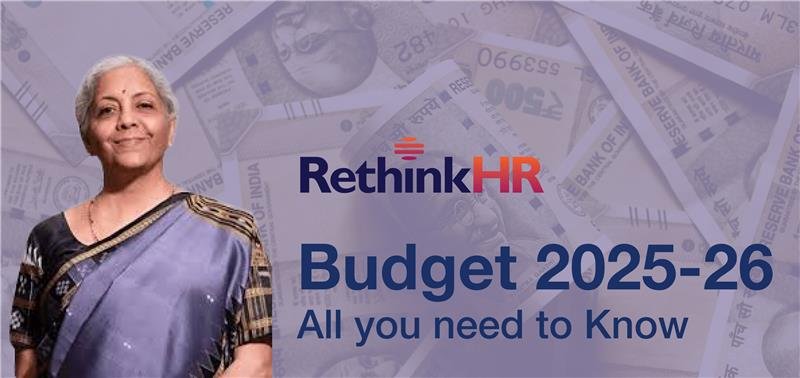The Union Budget 2025-26, presented by Finance Minister Smt. Nirmala Sitharaman, marks a pivotal moment in India’s economic journey. With the theme of “Sabka Vikas” (inclusive growth), this budget aims to address the aspirations of a diverse population, from middle-class households to large corporations. As we delve into the implications of this budget for human resources, it’s essential to understand how these fiscal policies will shape the workplace landscape in India.
Key Highlights of the Union Budget 2025-26
1. Tax Relief for Individuals
One of the most significant announcements is the revised income tax regime, which offers substantial relief to the middle class. Individuals with an annual income of up to ₹12 lakh will not be liable to pay any income tax, thanks to new tax slabs and a standard deduction of ₹75,000. This change is expected to increase disposable income, thereby enhancing employee morale and spending power. With more money in their pockets, employees are likely to feel more financially secure, which can lead to increased productivity and engagement at work.
2. Support for Startups and MSMEs
The budget emphasizes support for Micro, Small, and Medium Enterprises (MSMEs) through enhanced credit guarantees and extended tax exemptions for startups. This initiative is crucial as MSMEs are the backbone of the Indian economy, contributing significantly to employment generation. By fostering entrepreneurship, the government is paving the way for job creation across various sectors. HR leaders should prepare to adapt their talent acquisition strategies to tap into this growing pool of entrepreneurial talent, potentially integrating flexible work arrangements that cater to the needs of startup culture.
3. Investment in Skill Development
With a focus on enhancing workforce capabilities, the budget allocates resources for skill development programs aimed at improving employability. The introduction of initiatives like the Prime Minister Dhan-Dhaanya Krishi Yojana and increased loan limits under the Kisan Credit Card (KCC) scheme will empower workers in agriculture and related sectors. Moreover, investments in vocational training and educational programs can help bridge the skills gap in various industries. HR departments should align their training programs with these national initiatives to foster a skilled workforce that meets evolving market demands.
4. Emphasis on Digital Infrastructure
The government’s commitment to improving digital infrastructure is evident through investments in broadband connectivity and technology-driven education initiatives such as Atal Tinkering Labs in schools. As remote work becomes more prevalent, organizations must enhance their digital capabilities and ensure that employees have access to necessary tools and resources. This includes investing in cybersecurity measures and providing training on digital tools that facilitate collaboration and productivity. HR teams should also consider how these improvements can enhance employee experiences and satisfaction.
5. Focus on Diversity and Inclusion
The budget acknowledges the importance of inclusive growth, which aligns with RethinkHR’s commitment to diversity and inclusion. The proposed support for women entrepreneurs and marginalized communities through targeted schemes is a positive step toward fostering an equitable workplace. This focus on diversity not only enhances organizational culture but also drives innovation by bringing varied perspectives into decision-making processes. HR leaders should leverage these initiatives to enhance their DEI strategies by implementing targeted recruitment practices and creating supportive environments for diverse talent.
6. Health and Well-being Initiatives
The budget also highlights an increased allocation for health services, emphasizing mental health support as part of overall employee well-being strategies. As organizations continue to navigate post-pandemic challenges, prioritizing mental health initiatives will be crucial in fostering a supportive workplace culture. HR departments should integrate mental health resources into their employee assistance programs (EAPs) and promote awareness around mental wellness.
Implications for Human Resources
As organizations navigate the implications of the Union Budget, HR leaders must strategically align their policies with government initiatives:
- Talent Acquisition: With increased support for startups and MSMEs, HR teams should refine their recruitment strategies to attract talent from these sectors while promoting flexible working conditions that resonate with startup culture.
- Training and Development: Invest in skill development programs that resonate with government initiatives, ensuring employees are equipped for future challenges while aligning training content with industry needs.
- Employee Engagement: Utilize tax relief measures as a talking point in employee engagement strategies, emphasizing how these changes positively impact their financial well-being.
- Diversity Initiatives: Actively promote diversity and inclusion within the organization by aligning with government policies aimed at supporting underrepresented groups.
- Health & Wellness Programs: Integrate mental health initiatives into workplace culture by providing access to resources that support overall well-being.
Conclusion
The Union Budget 2025-26 reflects a balanced approach that not only provides tax relief but also fosters entrepreneurship, strengthens agriculture, invests in technology and innovation, and prioritizes health and well-being. For HR leaders at RethinkHR, this budget presents an opportunity to align organizational strategies with national priorities while ensuring that employees are supported in their professional journeys. As we move forward, it is crucial for HR professionals to stay informed about these developments and adapt their strategies accordingly. By doing so, they can play a pivotal role in shaping a resilient workforce ready to meet the challenges of tomorrow while contributing positively to India’s broader economic goals.

